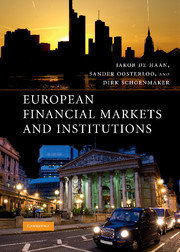Book contents
- Frontmatter
- Contents
- List of Boxes
- List of Figures
- List of Tables
- List of Countries
- List of Abbreviations
- Preface
- Part I Setting the Stage
- 1 Functions of the Financial System
- 2 European Financial Integration: Origins and History
- Part II Financial Markets
- Part III Financial Institutions
- Part IV Policies for the Financial Sector
- Index
- References
2 - European Financial Integration: Origins and History
from Part I - Setting the Stage
- Frontmatter
- Contents
- List of Boxes
- List of Figures
- List of Tables
- List of Countries
- List of Abbreviations
- Preface
- Part I Setting the Stage
- 1 Functions of the Financial System
- 2 European Financial Integration: Origins and History
- Part II Financial Markets
- Part III Financial Institutions
- Part IV Policies for the Financial Sector
- Index
- References
Summary
OVERVIEW
The European Union consists of 27 Member States at the time of writing and has supranational and intergovernmental forms of co-operation. The EU has its origins in the European Coal and Steel Community (ECSC) formed by six European countries in 1951. Since then, it has grown in size through the accession of new Member States, while it has also increased its powers by the addition of new policy areas to its remit.
This chapter describes the major steps towards monetary and financial integration in the European Union. In addition, it explains the most important EU institutions (European Commission, Council of the EU, European Council, the European Parliament, and the European Court of Justice) and legal instruments (like directives and regulations).
A major step in the history of European integration was the publication of the report of the Committee for the Study of Economic and Monetary Union in 1989. In this so-called Delors Report, named after the chairman of this committee, a three-phase transition towards monetary unification was proposed. The main conclusions of the Delors Committee were incorporated in the 1992 Treaty on European Union and finally led to the introduction of the single currency as well as the European Central Bank (ECB).
An important milestone for financial integration was the launch of the Financial Services Action Plan (FSAP) by the European Commission in May 1999.
- Type
- Chapter
- Information
- European Financial Markets and Institutions , pp. 33 - 60Publisher: Cambridge University PressPrint publication year: 2009
References
- 1
- Cited by



